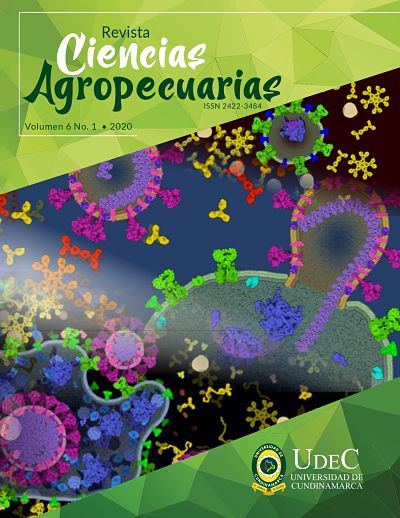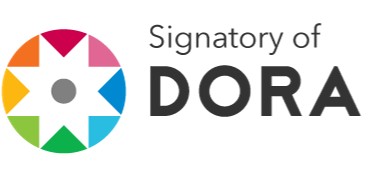Evaluation of the effectiveness of Trichoderma sp. antagonism on different phytopathogenic fungi present in corn crops (Zea mays)
DOI:
https://doi.org/10.36436/24223484.279Keywords:
Trichoderma, Competencia, incidencia y severidad.Abstract
This study included fieldwork in a corn crop and a second phase in the microbiology laboratory at the University of Cundinamarca. In the field, various rust agents were found, including Alternaria sp., Cladiosporum sp., and Verticilium sp. due to fungal diseases. Regarding bacterial diseases, staining techniques suggest the presence of actinomycetes that cause soft rot, responsible for the loss of corn flower. A higher incidence and severity were calculated for rust (incidence: 100%; severity: 100%), so in this crop it stood out as the causal agent present in all the plants evaluated. The effectiveness of the mycoparasite Trichoderma sp. was evaluated. against phytopathogenic fungi isolated from corn plants, through antagonism tests between the mycoparasitic agent and the phytopathogenic agent, obtaining a greater antagonism of the mycoparasite against Verticillium and the other agents by 49%, presenting antagonism by competition and antibiosis.Downloads
References
Deras H. Guía técnica. El cultivo de maíz. s. f. Disponible en: http://repiica.iica.int/docs/b3469e/b3469e.pdf
Ortigoza J., López C, González, J. Guía técnica cultivo de maíz. 2019. San Lorenzo, Paraguay. Disponible en: https://www.jica.go.jp/paraguay/espanol/office/others/c8h0vm0000ad5gke-att/gt_04.pdf
Carmona M, Sautua F. Sanidad de los cultivos, cómo y cuándo aplicar fungicidas para evitar roya y tizón en maíz. 2009. Disponible en: https://www.clarin.com/rural/aplicar-fungicidas-evitar-royatizon-maiz_0_SkzSaSPyf.html
Ventimiglia L, Torrens L. (2015). Aplicación de fungicida en maíz: efecto del genotipo, momento e intensidad de la aplicación. Disponible en: https://inta.gob.ar/sites/default/files/script-tmp-inta_9_de_julio_aplicacin_de_fungicida_en_maz_efecto_.pdf
García-Gutiérrez C, Rodríguez-Mesa. GD. Problemática y riesgo ambiental por el uso de plaguicidas en Sinaloa. Ra Ximhai. 2012;8(3b):1-10. Disponible en: https://www.redalyc.org/pdf/461/46125177005.pdf
Martínez B, Infante D, Reyes Y. Trichoderma spp. y su función en el control de plagas en los cultivos. 2013. Disponible en:
ttp://scielo.sld.cu/scielo.php?script=sci_arttext&pid=S1010-27522013000100001
González G. Análisis de incidencia y severidad de fitopatologías. Pontificia Universidad Javeriana. Trabajo de grado. Microbiología
agrícola y veterinaria. 2007.
Rodríguez P, Arenas R. Hans Christian Gram y su tinción. 2018. Disponible en: https://www.medigraphic.com/pdfs/cosmetica/dcm-2018/dcm182n.pdf
Barroso-Albarracín R, Chaki M, Carreras A, Pérez-Artés E, Valderrama R, et al. Trichoderma harzianum como agente de control biológico frente a la Verticilosis del olivo. 2014. Disponible en: https://digital.csic.es/handle/10261/159328
Jakobs D, Geremia RA, Goldman GH, Kaomen O, Van Montagy M, Herrera EA. Study of the expression of b-(1-3) glucanase of Trichoderma harzianum. Petria. 1991;1:125-126.
Bruce A, Srinivasan U, Stanines HJ, Highley TL. Chitinase and laminarinase production in liquid cultura by Trichoderma spp., and their role in biocontrol of Wood decay fungi. lnternational Biodeterioration & Biodegradation. 1995;35(4):337-353.
https://doi.org/10.1016/0964-8305(95)00047-3
Benhamou N, Chet l. Cellular and molecular mechanisms involved in the interaction between Trichoderma harzianum and Pythium ultimum. Appl. Environ. Microbiol. 1997;63(5):2095-2099. https://doi.org/10.1128/AEM.63.5.2095-2099.1997
Schickler H., Chet l. Heterologous chitinase gene expression to improve plant defense against phytopathogenic fungi. Journal of Industrial Microbiology & Biotechnology. 1997;19:196-201.https://doi.org/10.1038/sj.jim.2900447
Caiza Sango SE. Evaluación in vitro de la capacidad antagónica de Trichoderma comercial (Trichoderma harzianum) y Trichoderma nativo (Trichoderma sp.) frente a los patógenos Alternaria sp.,
Fusarium oxysporum y Heterosporium echinolatum del cultivo
de clavel (Dianthus caryophyllus). Bachelor’s thesis, Quito. 2017.
Moreno M, González I, Marín de Santos R, García T. Importancia
del género Alternaria como productor de micotoxinas y agente causal de enfermedades humanas. Nutrición Hospitalaria. 012;27(6):1772-1781. Disponible en: http://scielo.isciii.es/pdf/nh/v27n6/03revision02.pdf
Shalini R, Prem LK, Sudheer K, Alok KS, Pramod WR. Identification, characterization and phylogenetic analysis of Antifungal Trichoderma from tomato rhizosphere. Springer Plus.
;5(1939):1-16. https://doi.org/10.1186/s 40064-016-3657-4
Guédez C, Cañizalez L, Castillo C, Olivar R. Evaluación in vitro de aislamientos de Trichoderma harzianum para el control de hizoctonia solani, Sclerotium rolfsii y Fusarium oxysporum en plantas de tomate. Sociedad Venezolana de Microbiología. 2012;1(32):44-49. Disponible en: http://www.scielo.org.ve/pdf/rsvm/v32n1/art09.pdf
Michel A. Cepas nativas de Tricoderma spp. (Euscomycetes: hypocreales), su antibiosis y micoparasitismo sobre Fusarium subglutinans y F. oxysporum (Hyphomycetes: Hyphales). Tesis doctoral, Universidad de Colima, México. 2001.
Rolz C, De León L, Paniagua O. Evidencia de un antagonismo in vitro de especies de Trichoderma contra Hemileia vastatrix (Roya del café). Rev. 25 de la Universidad del Valle de Guatemala. 2013;61-65.
Sucaticona Vilca F. Actividad antagónica in vitro de los hongos Trichoderma spp. y Lecanicillium spp. frente al hongo de la roya amarilla del café (Hemileia vastatrix) en condiciones de laboratorio. Tesis, Universidad Nacional del Altiplano, Perú. 2018.
Downloads
Published
How to Cite
Issue
Section
License
Copyright (c) 2020 Revista Ciencias Agropecuarias

This work is licensed under a Creative Commons Attribution-NonCommercial-NoDerivatives 4.0 International License.







